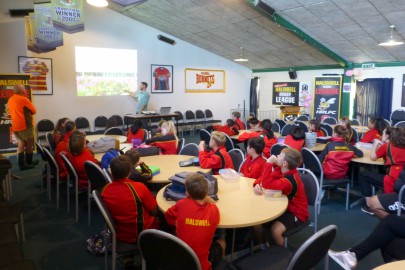Halswell Domain field trip
In this section
-
Participating schools
- Curious Minds visit Lincoln
- Franz Josef & Fox Glacier Schools
- Greymouth High School
- Haast School
- Halswell Domain
- Halswell School
- Heathcote Valley School
- Kaniere School
- Kaniere visit Lincoln
- Hokitika Primary
- Leeston Consolidated School
- Manuka Primary School
- Mission Heights
- Mt Albert Grammar
- Paroa School
- Rudolf Steiner School
- Takapuna Grammar
- TKKM
- Wakaaranga Primary School
- Whataroa School

Richard Langley (ECan) speaking to Halswell School students about weeds of Canterbury waterways and their control. Image: Murray Dawson
This field trip was useful for several reasons. During our visits to the school the students only had time for a short walk to discover local plants near their grounds after our classroom lessons, and the Halswell Domain provided a large and interesting new place to explore. Also, the theme for our South Island delivery was ‘weeds of watersides’ and the domain has a pond and boundary creek to find plants growing in wet habitats.
Joining us at the domain were Richard (‘Rich’) Langley, Project Coordinator – Biosecurity from Environment Canterbury (ECan), and Ian (‘Hank’) Hankin, Services Ranger from the Department of Conservation (DOC), to talk about the practical control work that they undertake to manage invasive plants of watersides. This provided excellent extension of the in-school lessons provided last year by Robinne Weiss (independent educator), Murray Dawson and Hugh Gourlay (Manaaki Whenua – Landcare Research).
At 12.30 pm, Richard, Ian, Murray and Robinne met teachers Lisa Dovey (Year 6–8 Team Leader) and Ben Gauqau, along with 25 Y7 school students in the Halswell Hornets Clubrooms. These clubrooms were well set up with lots of seating and tables to spread out our free handouts for the students (a wide range of booklets on weeds, and Weedbusters branded drink-bottles, pens, pencils, etc.).
After welcomes and introductions, Richard and Ian explained what they do in their jobs at ECan and DOC, and they talked about their control work of weeds. They presented an interesting PowerPoint ‘Weeds of Waterways: Protecting Biodiversity by managing the spread of pests across the Canterbury Region’. They profiled spartina, purple loosestrife, and great willowherb, explaining what each plant is, why it’s a problem, where it likes to grow, and what practical methods are used to control them. We learnt that:
Spartina (Spartina or Sporobolus as its now botanically known)
- Is a clumping grass that grows to about a metre tall
- Likes to grow in brackish water
- Invades mangroves, mudflats and estuaries, taking over the inter-tidal zone
- Traps sediment and alters habitat that supports wading birds, whitebait, eels and flounder
- Spreads easily, with seeds that can be carried in moving water
Purple loosestrife (Lythrum salicaria)
- Can have up to 50 stems and grows up to 3 m tall
- Has pretty pink-purple flowers in summer, but is considered one of the worst environmental and economic weeds in the world
- Invades waterways and wetlands altering habitat, affecting native plants and animals
- Clogs waterways and drains
- Can produce several million seeds in a summer
- Has root and stem fragments that can float downstream and re-establish
Great willowherb (Epilobium hirsutum)
- Grows up to 2 m tall with large, pink-purple flowers
- Typically grows in wet or damp habitats
- Only recently arrived in New Zealand and is only found in Canterbury
- Invades marshlands, ditches and the banks of rivers and streams, crowding out native wetland plants
- Clogs waterways and wetlands reducing water flow
- Grows rapidly and produces fluffy seed that disperses in the wind.
After profiling each weed, we were shown pictures of control methods used in the field which included herbicide spraying, using quad bikes, removing flower-heads before seed set, and physical removal by digging the weeds out.
Murray reminded the class that they took part in another control method the previous year, biological control, when they released tradescantia beetles in Muir Park.
Richard and Ian also told us of the importance of reporting invasive weeds using tools such as the iNaturalist app which we used later that afternoon in the domain.
Robinne then divided the students into groups, and after a Health and Safety briefing, we spent the rest of the afternoon exploring the domain grounds (and adjacent community garden and cemetery) to record the weeds and cultivated plants growing there.
What were some of the plants that we found?
We encountered a wide range of plants, including several tree species, that were spreading around from original plantings in the domain. These included:
- Elm (Ulmus)
- European alder (Alnus glutinosa)
- European ash (Fraxinus excelsior)
- European holly (Ilex aquifolium)
- Ivy (Hedera)
- Oak (Quercus robur)
- Periwinkle (Vinca major)
- Silver wattle (Acacia dealbata)
- Stinking iris (Iris foetidissima)
- Sycamore (Acer pseudoplatanus)
- White poplar (Populus alba).
Other invasive woody species that we found, capable of arriving from further afield through bird dispersal, were Chilean maiten (Maytenus boaria), elderberry (Sambucus nigra), and European spindle tree (Euonymus europaeus).
Waterside weeds seen by us and other visitors to the domain included:
Funding
This trip was made possible by the Curious Minds MBIE Participatory Science Platform (PSP) and The Brian Mason Scientific & Technical Trust. A special thanks also to community iNaturalist Lloyd Esler for helping identify many of our observations added to the Halswell School project page.


